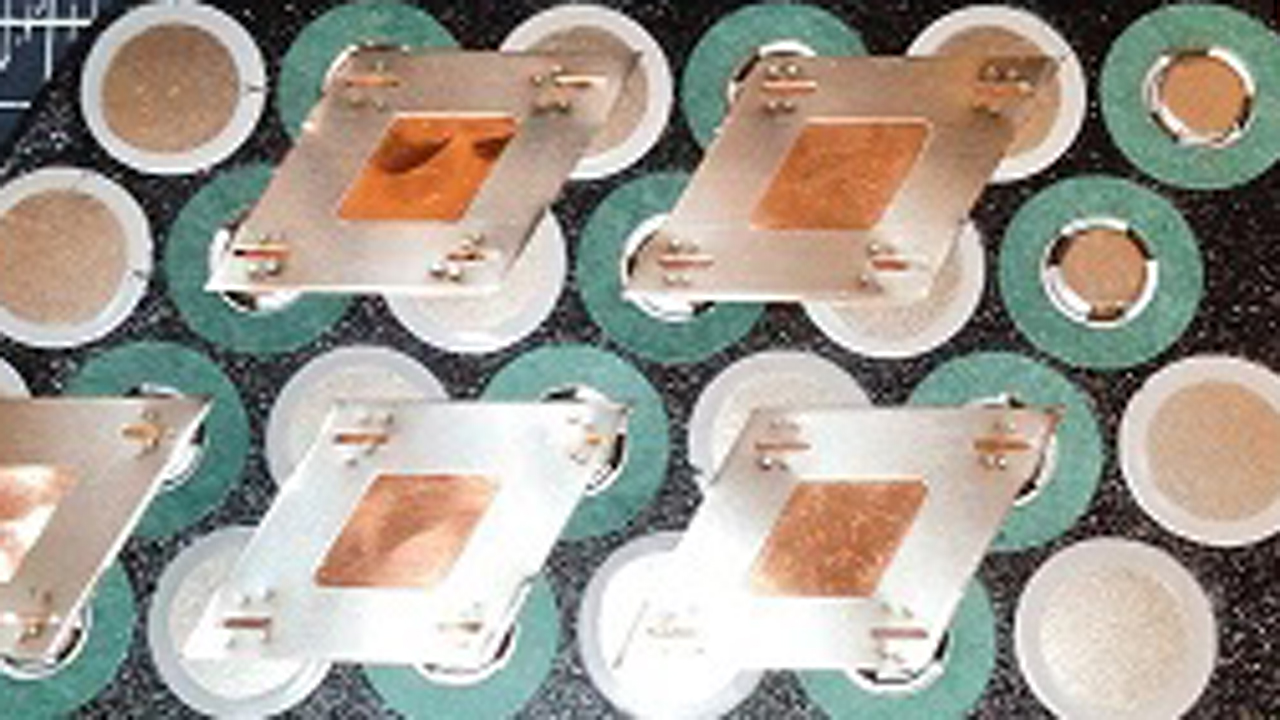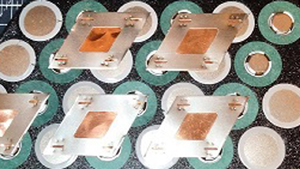Looking to learn about the intricate process of spot welding copper to nickel? Delving into the world of metal joining techniques, this article will uncover the essential aspects and challenges involved in this precise welding process. From exploring the conductivity benefits of combining copper and nickel to the technical intricacies of achieving a strong, durable bond, we’ll unravel the key elements crucial for successful spot welding in this context. Whether you are a welding enthusiast, a professional in the field, or simply curious about the science behind metal fabrication, understanding the nuances of spot welding copper to nickel is a fascinating journey.

Image by cellsaviors
Stay tuned as we explore the fusion of these two metals and the implications for various industries, shedding light on the art and science of spot welding copper to nickel. Get ready to uncover the secrets of achieving impeccable spot welds and the possibilities they unlock.
Understanding the Spot Welding Methods
Spot welding is a widely used technique for joining metal pieces together by creating a weld at specific points. It involves the application of pressure and heat to form the weld. In the case of spot welding copper and nickel, the process becomes more intricate due to the dissimilar nature of the metals and their varying conductive properties. Achieving a successful spot weld in this context requires a deep understanding of the materials involved and the welding process itself.
Spot welding copper to nickel presents a unique set of challenges due to the significant differences in the properties of these two metals. Copper is highly conductive, while nickel offers excellent corrosion resistance and strength. Combining these metals through spot welding requires careful consideration of the welding parameters and techniques to ensure a strong and durable bond.
Challenges of Spot Welding Copper to Nickel
One of the primary challenges in spot welding copper to nickel lies in managing the heat input during the welding process. Copper has high thermal conductivity, which means it can quickly dissipate heat. On the other hand, nickel has lower thermal conductivity, making it more prone to heat buildup. Balancing these properties to achieve a successful weld without overheating or damaging the materials is a critical challenge in spot welding copper to nickel.
Another challenge arises from the difference in melting points between copper and nickel. Copper has a lower melting point compared to nickel, requiring precise control of the welding parameters to prevent excessive melting of the copper while ensuring proper fusion with the nickel. The dissimilar nature of the metals can lead to the formation of brittle intermetallic compounds at the weld interface, affecting the integrity of the joint.
Factors to Consider Before Welding Copper to Nickel
Before undertaking the spot welding of copper to nickel, several factors must be carefully evaluated to ensure the success of the welding process. Understanding the thickness and surface conditions of the materials is essential, as these factors can influence the welding parameters and the overall quality of the weld. The choice of welding equipment and electrodes plays a crucial role in achieving reliable spot welds.
The electrical and thermal conductivity of copper and nickel must be taken into account when setting the welding parameters, including the welding current, time, and pressure. Proper alignment and fixturing of the materials are also vital to ensure consistent and precise welds. Furthermore, the presence of any surface contaminants or oxides must be addressed through appropriate cleaning and surface preparation methods to facilitate a strong weld interface.
Techniques for Spot Welding Copper to Nickel
Several techniques can be employed to overcome the challenges associated with spot welding copper to nickel and achieve high-quality welds. One effective approach involves the use of specialized welding equipment capable of delivering precise control over the welding parameters. This may include advanced spot welding machines equipped with microprocessor-based controls for accurate current and time settings.
In addition to equipment considerations, the use of optimized welding schedules tailored to the specific properties of copper and nickel is crucial. Through careful experimentation and process refinement, welding schedules can be fine-tuned to achieve the ideal balance of heat input and pressure, resulting in strong and reliable spot welds. Employing advanced welding techniques such as pulse welding can also offer benefits in controlling heat input and minimizing material distortion during the welding process.
Best Practices for Achieving a Strong Spot Weld
Achieving a strong spot weld between copper and nickel hinges on the implementation of best practices throughout the welding process. Proper electrode selection is paramount, with electrodes designed to accommodate the unique properties of both metals. Maintaining consistent electrode force and alignment is crucial to ensure uniform weld formation and minimize the risk of defects.
Controlling the welding parameters within the specified ranges is essential for achieving the desired weld quality. This includes setting appropriate welding currents and times based on the material thickness and conductivity. Implementing pre- and post-weld heating or cooling cycles can also help alleviate the thermal stresses within the welded materials, contributing to the overall strength and durability of the spot weld.
Advantages of Spot Welding Copper to Nickel
Spot welding copper to nickel offers numerous advantages, particularly in applications where the combined properties of these metals are beneficial. The conductivity of copper and the corrosion resistance of nickel make the welded joints suitable for a wide range of electrical and electronic applications. Additionally, the strength and durability of the spot welds enable their use in structural and industrial settings, where reliable metal joints are essential.
Spot welding provides a cost-effective and efficient method for joining copper and nickel, minimizing the need for additional materials or fasteners. The localized nature of spot welding also reduces the heat-affected zone, preserving the integrity of the surrounding materials. These advantages make spot welding an attractive choice for integrating copper and nickel in various manufacturing and assembly processes.
Applications of Spot Welding Copper to Nickel
The applications of spot welding copper to nickel span across diverse industries, showcasing the versatility and utility of this specialized welding technique. In the electrical and electronics sector, spot welded copper and nickel joints find use in manufacturing components such as battery tabs, electrical contacts, and circuitry elements. The high conductivity and reliability of these joints make them indispensable in ensuring efficient electrical performance.
Beyond electrical applications, spot welding copper to nickel is employed in the production of heat exchangers, where the combination of copper’s thermal conductivity and nickel’s corrosion resistance is highly advantageous. This extends to the automotive and aerospace industries, where spot-welded copper-nickel joints contribute to the fabrication of heat transfer components and structural elements. The versatility of spot welded copper and nickel assemblies continues to drive innovation across various sectors, highlighting the significance of this welding process.
Choosing the Right Spot Welding Equipment
Selecting the appropriate spot welding equipment is crucial for achieving successful welds when working with copper and nickel. Advanced spot welding machines equipped with precise control mechanisms and customizable welding schedules offer the necessary flexibility to accommodate the unique properties of these metals. Consideration should also be given to the electrode materials, ensuring compatibility with both copper and nickel to facilitate consistent and reliable welding performance.
The capacity of the spot welding equipment, including its power output and electrode force capabilities, should align with the specific requirements of the intended applications. Whether it’s small-scale electrical component manufacturing or large-scale industrial production, the right choice of spot welding equipment can significantly influence the quality and efficiency of the welding processes. Investing in modern, high-precision spot welding technology can yield substantial benefits in achieving superior copper-nickel spot welds.
Safety Measures for Spot Welding Copper to Nickel
As with any welding operation, ensuring the safety of personnel and the integrity of the work environment is paramount when spot welding copper to nickel. Adequate ventilation and fume extraction systems should be in place to mitigate the potential exposure to welding fumes and gases. Personal protective equipment, including eye protection, gloves, and appropriate clothing, is essential for welders and personnel working in the vicinity of the welding area.
Adherence to proper welding procedures and safety protocols is critical to prevent accidents and minimize the risks associated with spot welding operations. Maintaining a clean and organized workspace, free from clutter and potential hazards, contributes to a safe and efficient welding environment.
By prioritizing safety measures and implementing best practices, spot welding copper to nickel can be carried out with confidence and diligence, ensuring the well-being of all involved.
Conclusion
Spot welding copper to nickel presents a fascinating blend of challenges, techniques, and applications, underscoring the intricate nature of this specialized welding process. By understanding the conductivity benefits, technical complexities, and best practices associated with spot welding these dissimilar metals, the potential for achieving strong, durable welds is within reach. The advantages of spot welding copper and nickel extend across industries, showcasing the versatility and utility of this precise joining technique.
As technology and manufacturing processes continue to evolve, the demand for reliable and efficient metal joining methods remains steadfast. In this context, spot welding copper to nickel emerges as a valuable tool, offering a seamless fusion of conductive and corrosion-resistant properties. With the right knowledge, equipment, and safety measures in place, the art and science of spot welding copper and nickel pave the way for innovation and excellence in metal fabrication.
